|

by Bibhu Dev Misra
New
Dawn Special Issue
Vol. 11 No 3
(June
2017)
from
NewDawnMagazine Website
Spanish version
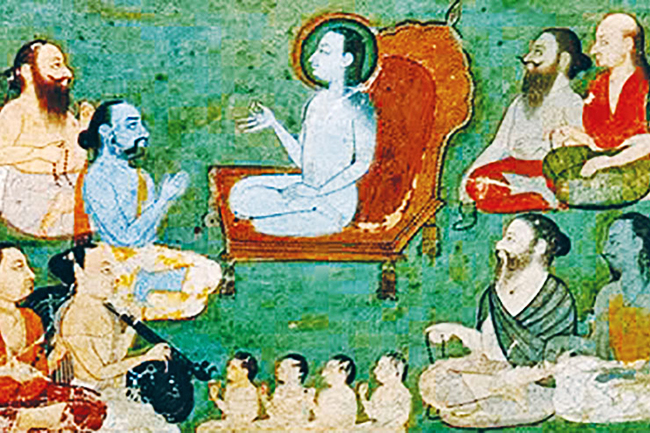
A number of ancient cultures believed in a Cycle of World Ages in
which we gradually descend from a state of spiritual perfection and
material abundance to one of ignorance and scarcity.
In ancient India, this
was called
the Yuga Cycle.
The Yuga Cycle
doctrine tells us that we are now living in the Kali Yuga; the
age of darkness, when moral virtue and mental capabilities reach
their lowest point in the cycle.
The Mahabharata describes the Kali Yuga as,
the period when the
"World Soul" is Black in hue; only one quarter of virtue
remains, which slowly dwindles to zero at the end of the Kali
Yuga.
Men turn to
wickedness; disease, lethargy, anger, natural calamities,
anguish and fear of scarcity dominate.
Penance, sacrifices
and religious observances fall into disuse.
All creatures
degenerate.
Change passes over
all things, without exception.
The Kali Yuga (Iron Age)
was preceded by three other Yugas:
In the Mahabharata,
Hanuman gives the following description of the Yuga Cycle to the
Pandava prince Bhima:
The Krita Yuga was so
named because there was but one religion, and all men were
saintly: therefore they were not required to perform religious
ceremonies...
Men neither bought
nor sold; there were no poor and no rich; there was no need to
labour, because all that men required was obtained by the power
of will...
The Krita Yuga was
without disease; there was no lessening with the years;
there was no hatred, or vanity, or evil thought whatsoever; no
sorrow, no fear.
All mankind could
attain to supreme blessedness. The universal soul was White...
the identification of self with the universal soul was the whole
religion of the Perfect Age.
In the Treta Yuga
sacrifices began, and the World Soul became Red; virtue lessened
a quarter. Mankind sought truth and performed religious
ceremonies; they obtained what they desired by giving and by
doing.
In the Dwapara Yuga
the aspect of the World Soul was Yellow: religion lessened
one-half.
The Veda was divided
into four parts, and although some had knowledge of the four
Vedas, others knew but three or one. Mind lessened, Truth
declined, and there came desire and diseases and calamities;
because of these men had to undergo penances.
It was a decadent Age
by reason of the prevalence of sin. 1
Now we are living in
the dark times of the Kali Yuga, when goodness and virtue
has all but disappeared from the world.
When did the Kali Yuga
begin, and when does it end?
In spite of the elaborate theological framework of the Yuga Cycle,
the start and end dates of the Kali Yuga remain shrouded in mystery.
The popularly accepted date for the beginning of the Kali Yuga is
3102 BCE, thirty-five years after the conclusion of the battle
of
the Mahabharata.
This date is believed to
be based on a statement made by the noted astronomer Aryabhatta
in the Sanskrit text Aryabhatiya, where he writes that:
When sixty times
sixty years (i.e. 3,600 years) and three quarter Yugas had
elapsed, twenty-three years had then passed since my birth.
2
This means that
Aryabhatta had composed the text when he was 23 years old and 3,600
years of the current Yuga had elapsed.
The problem here is that
we do not know when Aryabhatta was born, or when he composed the
Aryabhatiya. He does not even mention the Kali Yuga by name, and
simply states that 3,600 years of the Yuga had elapsed.
Scholars generally assume
that the Kali Yuga had started in 3102 BCE, and then use this
statement to justify that the Aryabhatiya was composed in 499 CE.
However, we cannot use
the reverse logic, i.e. we cannot say that the Kali Yuga must have
started in 3102 BCE since the Aryabhatiya was composed in 499 CE,
for we do not know when Aryabhatta lived or completed his work.
Another important source is the
Aihole inscription of Pulakesin
II of Badami, which was incised on the expiry of 3,735 years
after the Bharata war and 556 years of the Saka kings. 3
If we take the beginning
of the Saka Era as 78 CE, then the Bharata War took place in
3102 BCE, then the Kali Yuga, which started 35 years after the
Bharata War, began on 3067 BCE.
But we must remember
there is an Old Saka Era as well, whose beginning date is
disputed, and for which various dates have been proposed by scholars
ranging from 83 BCE - 383 BCE. 4
If the Aihole
inscription refers to the Old Saka Era, then the Kali Era
starts a few hundred years before 3102 BCE.
The truth is that there is no text or inscription which gives us an
unambiguous date for the beginning of the Kali Yuga. Although the
popularly accepted date is 3102 BCE, there is no astronomical basis
for it.
There is a claim that the
computation was based on the conjunction of the five 'geocentric
planets' (i.e. the planets visible to the naked eye) - Mercury,
Venus, Mars, Jupiter and Saturn - at 0° Aries at the beginning of
the Kali Yuga as mentioned in the Surya Siddhanta.
But the Surya Siddhanta
explicitly states that this conjunction of planets at 0° Aries takes
place at the end of the Golden Age. 5
Besides, modern
simulations indicate that on 17/18 February 3102 BCE, the five
geocentric planets occupied an arc of roughly 42° in the sky, which
cannot be considered as a conjunction by any means.
Therefore, neither is
there any astronomical basis for the start date, nor do we have any
evidence that Aryabhatta or any other astronomer had calculated the
date. Before the 6th century CE, the date does not occur in any
Sanskrit text or inscription. It could have been invented by later
day astronomers or adopted from some other calendar.
The vagueness surrounding
the origin of this very important chronological marker makes its
validity highly suspect.
The task of figuring out the start date of the Kali Yuga from the
ancient Sanskrit texts, however, is fraught with difficulties, since
a number of inaccuracies have crept into the Yuga Cycle information
contained within them.
In many Sanskrit texts
the 12,000-year duration of the Yuga Cycle was artificially inflated
to an abnormally high value of 4,320,000 years by introducing a
multiplication factor of 360, which was represented as the number of
'human years' which constitutes a 'divine year'.
In the book, The
Arctic Home in the Vedas (1903), B.G. Tilak wrote that:
The writers of the
Puranas, many of which appear to have been written during the
first few centuries of the Christian, era, were naturally
unwilling to believe that the Kali Yuga had passed away...
An attempt was,
therefore, made to extend the duration of the Kali Yuga by
converting 1,000 (or 1,200) ordinary human years thereof into as
many divine years, a single divine year, or a year of the gods,
being equal to 360 human years...
This solution of the
difficulty was universally adopted, and a Kali of 1,200 ordinary
years was at once changed, by this ingenious artifice, into a
magnificent cycle of as many divine, or,
360 × 1200 =
432,000 ordinary years. 6
Yuga Cycle of
24,000 Years
However,
certain important
Sanskrit texts such as the Mahabharata 7 and the
Laws of Manu, 8
which scholars believe were composed earlier than the Puranas,
still retain the original value of the Yuga Cycle as 12,000
years.
The Mahabharata
explicitly mentions that the Yuga Cycle duration is based on the
days and nights of human beings. The Zoroastrians also believed
in a Cycle of the Ages of 12,000 years' duration.
The Great Year
or Perfect Year of the Greeks was variously represented
as being of 12,954 years (Cicero) or 10,800 years (Heraclitus)
duration.
Surely, the Yuga Cycle
cannot be of different durations for different cultures.
In the book The Holy Science (1894) Sri Yukteswar
clarified that a complete Yuga Cycle takes 24,000 years, and is
comprised of an ascending cycle of 12,000 years when virtue
gradually increases and a descending cycle of another 12,000 years,
in which virtue gradually decreases.
Hence,
after we complete a
12,000-year descending cycle from Satya Yuga -> Kali Yuga, the
sequence reverses itself, and an ascending cycle of 12,000 years
begins which goes from Kali Yuga -> Satya Yuga.
Yukteswar states that,
"Each of these
periods of 12,000 years brings a complete change, both
externally in the material world, and internally in the
intellectual or electric world, and is called one of the Daiva
Yugas or Electric Couple." 9
The 24,000-year duration
of the complete Yuga Cycle closely approximates the Precessional
Year of 25,765 years, which is the time taken by the sun to 'precess',
i.e. move backwards, through the 12 Zodiac constellations.
Interestingly, the Surya
Siddhanta specifies a value of 54 arc seconds per year for
precession, as against the current value of 50.29 arc seconds per
year. This translates into a Precessional Year of exactly 24,000
years!
This means that the
current observed value of precession may simply be a temporary
deviation from the mean.
The concept of an ascending and descending cycle of Yugas is still
prevalent among the Buddhists and Jains. The Jains believe that a
complete Time Cycle (Kalachakra) has a progressive and a
regressive half.
During the progressive
half of the cycle (Utsarpini), there is a gradual increase in
knowledge, happiness, health, ethics, and spirituality, while during
the regressive half of the cycle (Avasarpini) there is a gradual
reduction in these qualities.
These two half cycles
follow each other in an unbroken succession for eternity, just like
the cycles of day and night or the waxing and waning of the moon.
The ancient Greeks
also appear to have believed in an ascending and descending
Cycle of Ages.
The Greek poet Hesiod
(c. 750 BCE - 650 BCE) had given an account of the World Ages in
Works and Days, in which he inserted a fifth age called the 'Age
of Heroes', between the Bronze Age and the Iron Age.
In Hesiod's Cosmos,
Jenny Strauss Clay writes:
Drawing on the
myth in Plato's Statesman, Vernant also claimed that the
temporal framework of Hesiodic myth, that is, the succession
of races, is not linear but cyclical.
At the end of the
age of iron, which he divides into two, the cycle of races
starts again with a new golden age or, more likely, a new
age of heroes, as the sequence reverses itself…
Vernant himself
offers a solution when he remarks that "there is not in
reality one age of iron but two types of human existence."
10
This is very interesting.
Jean-Pierre Vernant,
who is a highly-acclaimed specialist in ancient Greek culture,
believes that the Cycle of the Ages reverses itself as per Hesiod's
account.
Not only that, he states
the Iron Age has two parts, which corresponds to Yukteswar's
interpretation in which the descending Kali Yuga is followed by the
ascending Kali Yuga.
We can surmise, in this
context, that the 'Age of Heroes', which immediately followed the
Bronze Age in Hesiod's account, must be the name ascribed by Hesiod
to the descending Kali Yuga.
The evidence from different sources supports the notion of a
complete Yuga Cycle of 24,000 years, comprised of an ascending and
descending cycle of 12,000 years each.
This brings us to the
question of the relative durations of the different Yugas in the
Yuga Cycle, and the transitional periods, which occur at the
beginning and end of each Yuga, and are known as Sandhya
(dawn) and Sandhyansa (twilight) respectively.
The values in the
following table are provided in the Sanskrit texts for the duration
of the Yugas and their respective dawns and twilights:
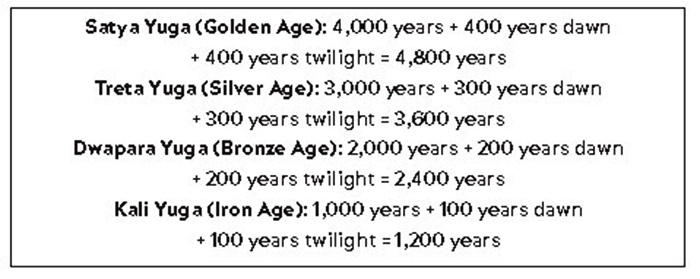
Yugas of Equal
Duration?
Since so many inaccuracies crept into the Yuga Cycle doctrine, as
pointed out by Yukteswar and Tilak, we also need to
question the accuracy of the relative durations of the Yugas
mentioned in the Sanskrit texts.
Although the Yuga Cycle
is mentioned in the mythic accounts of around thirty ancient
cultures, as described by Giorgio de Santillana, professor of
the history of science at MIT, in the book
Hamlet's Mill (1969), we find very
little information regarding the relative durations of the different
ages within this cycle.
In the few accounts where the durations of the Yugas are specified,
we find that each age in the Yuga Cycle is of the same duration.
For instance, the
Zoroastrians believe that the world lasts for 12,000 years,
which is divided into four equal ages of 3,000 years each.
A Mexican source
known as the
Codex Rios (also referred
to as Codex 3738 and Codex Vaticanus A) states that each age
lasts for 4,008, 4,010, 4,801 and 5,042 years respectively for a
total of 17,861 years.
We can see that in
this case also the duration of each age is nearly the same.
Therefore, the durations
of the four Yugas mentioned in the Sanskrit texts (i.e. 4,800,
3,600, 2,400, and 1,200 years) deviate from the norm.
The duration of each
Yuga, in this sequence, decreases by 1,200 years from the
previous one.
This is an arithmetic
progression which is rarely, if ever, found in natural cycles.
Could it be that the Yuga
durations were deliberately altered at some point in the past in
order to give the impression that the duration of each Yuga
decreases in tandem with the decrease in virtue from one Yuga to the
next?
Here is the most startling fact: Two of the most famous astronomers
of ancient India, Aryabhatta and Paulisa, believed
that the Yuga Cycle is comprised of Yugas of equal duration!
In the 11th
century, the medieval scholar Al-Beruni had compiled a
comprehensive commentary on Indian philosophy, sciences and culture
titled Alberuni's India, in which he mentions that the Yuga Cycle
doctrine was based on the derivations of the Indian astronomer
Brahmagupta, who in turn derived his knowledge from the Sanskrit
Smriti texts. He makes an interesting statement in this regard:
Further, Brahmagupta
says that "Aryabhatta considers the four yugas as the four equal
parts of the caturyuga (Yuga Cycle). Thus he differs from the
doctrine of the book Smriti, just mentioned, and he who differs
from us is an opponent." 11
The fact that Aryabhatta
believed the four Yugas to be of equal duration is extremely
pertinent!
Al-Beruni reasserts this
in no uncertain terms:
"Therefore, according
to Aryabhatta, the Kali Yuga has 3,000 divya years... each two
yugas has 6,000 divya years... each three years has 9,000 divya
years."
Why would Aryabhatta
subscribe to such a belief? Did he have access to sources of
information that are lost to us now?
Paulisa, another celebrated astronomer of ancient India, also
subscribed to the idea of Yugas of equal duration. Alberuni says
that, while presenting the calculations for the duration of a kalpa,
"he (Pulisa) has not
changed the caturyugas into exact yugas, but simply changed them
into fourth parts, and multiplied these fourth parts by the
number of years of a single fourth part." 12
Thus, two of the most
respected astronomers of ancient India, Aryabhatta and Paulisa,
believed in a Yuga Cycle that comprised of 4 Yugas of equal duration
of 3,000 divine-years each.
However, their opinion
was overshadowed by the contradictory view held by Brahmagupta. He
railed against Aryabhatta and the other astronomers who held
differing opinions, and even abused them.
Al-Beruni says about
Brahmagupta:
He is rude enough to
compare Aryabhatta to a worm which, eating the wood, by chance
describes certain characters in it without understanding them
and without intending to draw them.
"He, however, who
knows these things thoroughly, stands opposed to Aryabhatta,
Srishena, and Vishnucandra like the lion against gazelles.
They are not capable of letting him see their faces."
In such offensive
terms he attacks Aryabhatta and maltreats him. 13
We can now understand why
Brahmagupta's opinion finally prevailed over that of the other
astronomers of his time, and it certainly did not have anything to
do with the inherent soundness of his logic, or the authenticity of
his sources.
It is time for us to stop standing in opposition to Aryabhatta,
Paulisa, Srishena, Vishnucandra and others like the "lion against
gazelles," and instead take cognizance of the very real possibility
that the Yugas in the Yuga Cycle are of equal duration, and the
4:3:2:1 sequence of the Yugas may have been a mathematical
manipulation that crept into the Yuga Cycle doctrine sometime prior
to 500 CE.
It is possible this
manipulation was introduced because people were inclined to believe
that the duration of a Yuga should decrease in tandem with the
decrease in virtue and human longevity from one Yuga to the next.
A neat formula was
devised in which the total duration of the Yugas added up to 12,000
years.
However, there was one
problem.
If the Kali Yuga is
of 1,200 years duration, then it should have been completed many
times over, since its proposed beginning in 3102 BCE.
In order to circumvent
this potentially embarrassing situation, another complexity was
introduced.
Each 'year' of the
Yuga Cycle became a 'divine year' comprised of 360 human years.
The Yuga Cycle became
inflated to 4,320,000 years (12,000×360) and the Kali Yuga became
equal to 432,000 years (1,200×360). Humanity became consigned to an
interminable duration of darkness.
Original Yuga
Cycle Encoded into Saptarishi Calendar
The original Yuga Cycle doctrine appears to have been very simple:
A Yuga Cycle duration
of 12,000 years, with each Yuga lasting for 3,000 years.
This cycle is encoded
in the Saptarishi Calendar which has been used in India for
thousands of years. It was used extensively during the Maurya
period in the 4th century BCE, and is still in use in
some parts of India.
The term Saptarishi
refers to the 'Seven Rishis' or the 'Seven Sages' representing
the seven stars of the Great Bear constellation (Ursa Major).
They are regarded as
the enlightened rishis who appear at the beginning of
every Yuga to spread the laws of civilization.
The Saptarishi
Calendar used in India had a cycle of 2,700 years; it is said
that the
Great Bear constellation stays
for 100 years in each of the 27 Nakshatras (lunar asterisms)
which adds up to a cycle of 2,700 years. 14
The 2,700-year cycle
was also referred to as a Saptarishi Era or a Saptarishi Yuga.
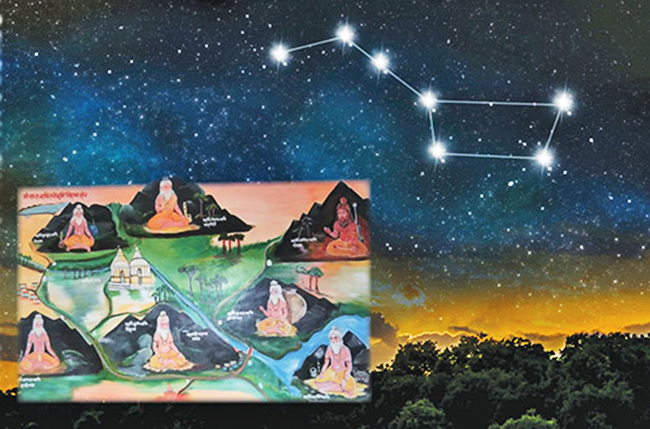
The Great Bear constellation (Ursa Major)
is clearly visible in the northern sky throughout the year.
The seven prominent stars represent the Seven Sages (Saptarishi),
each one depicted in the painting.
If the 2,700 year cycle of the
Saptarishi Calendar represents
the actual duration of a Yuga, then the remaining 300 years out of
the total Yuga duration of 3,000 years automatically represents the
'transitional period', before the qualities of the subsequent Yuga
are fully manifested.
The total duration of the
Yuga Cycle, excluding the transitional periods, is equal to
(2,700×4), i.e. 10,800 years, the same as the duration of the 'Great
Year of Heraclitus' in Hellenic tradition!
This clearly indicates
the underlying basis of the Cycle of the World Ages in both India
and Greece was the 2,700 year Saptarishi Cycle.
It is agreed by historians that the Saptarishi Calendar, in use
during the Maurya period in the 4th century BCE, started in 6676
BCE.
In the book Traditions
of the Seven Rsis, Dr. J.E. Mitchiner confirms this:
We may conclude that
the older and original version of the Era of the Seven Rsis
commenced with the Seven Rsis in Krttika in 6676 BCE...
This version was in
use in northern India from at least the 4th century
BCE, as witnessed by the statements of Greek and Roman writers;
it was also the version used by Vrddha Garga, at around the
start of the Christian era. 15
In fact, the recorded
chronology of Indian kings goes back further than 6676 BCE as
documented by the Greek and Roman historians Pliny and
Arrian.
Pliny states that,
"From Father Liber
[Roman Bacchus or Greek Dionysus] to Alexander the Great (d. 323
BCE), Indians reckon 154 kings, and they reckon (the time as)
6,451 years and 3 months." 16
Arrian puts 153 kings and
6,462 years between Dionysus and Sandrokottos (Chandragupta Maurya),
to whose court a Greek embassy was sent in 314 BCE. 17
Both indications add up
to a date of roughly c.6776 BCE, which is a 100 years prior to the
beginning of the Saptarishi Calendar in 6676 BCE.
It is obvious from the accounts of Pliny and Arrian that they must
have identified a specific king in the Indian kings list who
corresponded to the Greek Dionysus or Roman Bacchus, and whose reign
had ended at around c.6776 BCE.
Who could that have been?
According to the renowned
scholar and Orientalist Sir William Jones, Dionysus or
Bacchus was none other than the Indian monarch Rama.
In his essay "On the Gods
of Greece, Italy and India" (1784), Sir William Jones deems Rama to
be the same as the Grecian Dionysos, who is said to have conquered
India with an army of satyrs, commanded by Pan; and Rama was also a
mighty conqueror, and had an army of large monkeys or satyrs,
commanded by Maruty (Hanuman), son of Pavan.
Rama is also found, in
other points, to resemble the Indian Bacchus. 18
Sir William Jones also points out that,
Meros is said by the
Greeks to have been a mountain of India, on which their Dionysus
was born, and that Meru is also a mountain near the city of
Naishada, or Nysa, called by the Grecian geographers
Dionysopolis, and universally celebrated in the Sanskrit poems.
19
The identification of
Dionysus with Rama provides us with fresh perspectives.
According to the Indian
tradition, Rama lived towards the end of the Treta Yuga (Silver
Age), and the Dwapara Yuga (Bronze Age) had started soon after his
demise.
This implies that the
6676 BCE date for the beginning of the Saptarishi Calendar, which is
100 years after Dionysus, i.e. Rama, indicates the beginning of the
Dwapara Yuga in the descending cycle.
A later Saptarishi Calendar, still in use in India, began
from 3076 BCE.
But, as Dr. Subhash Kak
points out,
"the new count that
goes back to 3076 BCE was started later to make it as close to
the start of the Kali era as possible." 20
In the book Traditions
of the Seven Rsis, Dr. Mitchiner says that the Saptarishi
Calendar for the Kali Yuga (the Kashmir Laukika Abda) started when
the Saptarishis were in Rohini.
Since the Saptarishis
were in Rohini in 3676 BCE, it implies the Kali Yuga cycle must have
commenced in 3676 BCE.
Tracking Down
the True End Date of Current Kali Yuga
Now this is where it gets interesting.
A Saptarishi Era began in
6676 BCE, and another cycle started exactly 3,000 years later in
3676 BCE. But the Saptarishi Cycle is of 2,700 years' duration.
Why did the Saptarishi
Era for the Kali Yuga start 3,000 years after the previous cycle?
This means a 300-year
'transitional period' must have been added to the end of the
previous cycle! It clearly proves the hypothesis that the 2,700 year
Saptarishi Cycle, along with a 300-year transitional period, was the
original calendrical basis of the Yuga Cycle.
If we use the 6676 BCE date as the beginning of the Dwapara Yuga in
the descending cycle, and the 2,700 year Saptarishi Cycle along with
a 300-year transitional period as the basis for the Yuga Cycle, then
the entire timeline of the Yuga Cycle is unraveled.
This Yuga Cycle timeline takes the beginning of the Golden Age to
12676 BCE, more than 14,500 years before present, when the Great
Bear was in the Shravana nakshatra (the Great Bear will advance by 3
nakshatras in every Yuga because of the 300-year transitional
period).
This agrees very well
with the Indian tradition, since the Mahabharata mentions that in
the ancient tradition the Shravana nakshatra was given the first
place in the nakshatra cycle.
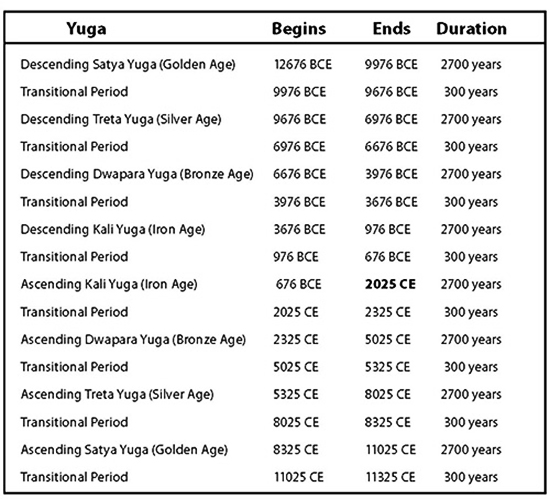
Yuga Cycle timeline
based
on the Saptarishi Calendar.
According to this interpretation, the Kali Yuga ends in 2025,
to be
followed by a 300 year transitional period
leading
up to the Ascending Dwapara Yuga.
The timeline also indicates that the ascending Kali Yuga, which is
the current epoch in which we are living, will end in 2025 CE.
The full manifestation of
the next Yuga - the ascending Dwapara - will take place in 2325 CE,
after a transitional period of 300 years. The ascending Dwapara Yuga
will then be followed by two more Yugas:
the ascending Treta
Yuga and the ascending Satya Yuga, which completes the 12,000
year ascending cycle.
The Sanskrit text Brahma-vaivarta
Purana describes a dialogue between Lord Krishna and the Goddess
Ganges.
Here, Krishna says that
after 5,000 years of Kali Yuga there will be a dawn of a new Golden
Age that lasts for 10,000 years (Text 50, 59). This can be
immediately understood in the context of the Yuga Cycle timeline
described here.
We are now ending the
Kali Yuga, nearly 5,700 years since its beginning in 3676 BCE.
And the end of the Kali
Yuga will be followed by three more Yugas spanning 9,000 years,
before the ascending cycle ends.
Archaeological
& historical evidence
According to the Yuga Cycle doctrine,
the transitional
periods between the Yugas are associated with a collapse of
civilizations and environmental catastrophes (pralaya),
which wipe out virtually every trace of any human civilization.
The new civilization
that emerges in the new Yuga is guided by a few survivors of the
cataclysm, who carry with them the technical and spiritual
knowledge of the previous epoch.
Many ancient sources tell
us of the enigmatic group of 'Seven Sages' ('Saptarishi') who are
said to appear at the beginning of every Yuga and promulgate
the arts of civilization.
We find them in myths
across the world - in Sumeria, India, Polynesia, South America
and North America...
They possessed infinite
wisdom and power, could travel over land and water, and took on
various forms at will.
The Saptarishi
Calendar of ancient India appears to have been based on their
periodic appearance at the beginning of every Yuga.
As we shall see, the Yuga Cycle timeline proposed here correlates
very strongly with the major cataclysmic events that periodically
impact our planet, and with a number of important dates recorded in
various ancient calendars and scriptures.
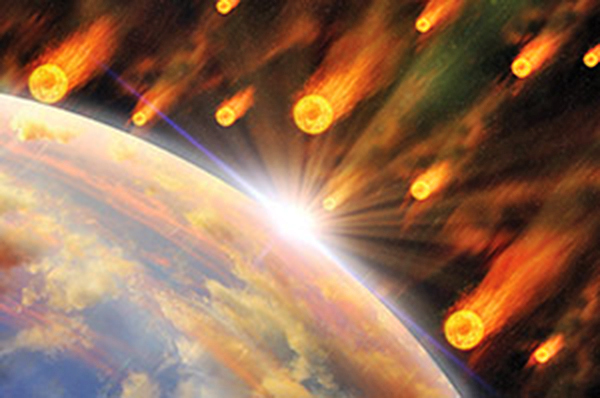
The planet
was subjected to sudden and destructive,
deep-water, oceanic comet impacts
during the 300-year transitional period
at the end of the last Golden Age,
circa 9600 BCE.
The first transitional period in the 12,000-year descending Yuga
Cycle is the 300-year period at the end of the Golden Age from 9976
BCE - 9676 BCE. This is the time when the last Ice Age came to a
sudden end; the climate became very warm quite abruptly, and there
was a catastrophic global flooding.
Many ancient legends
refer to this time period...
In the Timaeus,
Plato tells us of the mythical island of Atlantis which was
swallowed up by the sea in a "single day and night of misfortune" in
c.9600 BCE.
The Zoroastrians believe
the world was created by Ahura Mazda at around 9600 BCE, (i.e. 9,000
years before the birth of their prophet Zoroaster in c.600 BCE).
This event has also been recorded in the flood myths of many ancient
cultures, which almost uniformly talk of enormous walls of water
that submerged the entire land to the highest mountain tops, along
with heavy rain, fireballs from the sky, intense cold and long
periods of darkness.
Archaeologist Bruce
Masse of the Los Alamos National Laboratory in New Mexico
examined a sample of 175 flood myths from different cultures around
the world and concluded that the environmental aspects described in
these events, which is also consistent with the archaeological and
geophysical data, could have only been precipitated by a
destructive, deep-water, oceanic comet impact. 21
In recent years, a team of international scientists found compelling
evidence that the Earth was bombarded by multiple fragments of a
giant comet nearly 12,800 years ago, triggering the start of a rapid
and intense cooling period called
Younger Dryas, which lasted for
nearly 1,200 years till c.9700 BCE.
The force of the comet
impact, combined with the vicious cold snap that followed, brought
about the extinction of a large number of North American megafauna
including woolly mammoths and giant ground sloths, and ended a
prehistoric civilization called the
Clovis culture - the first human
inhabitants of the New World. 22
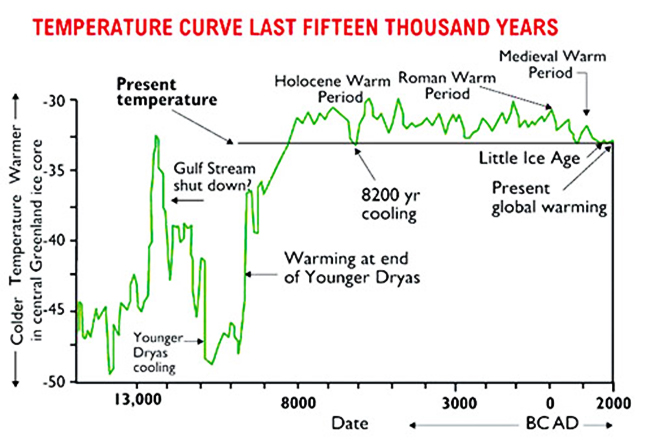
This temperature graph
shows
the sudden cooling
at the
beginning of the Younger Dryas
and an
equally sudden warming
at the
end of the Younger Dryas.
The Younger Dryas ended as abruptly as it started, for reasons not
fully understood.
Geologists from the
Niels Bohr Institute (NBI) in Copenhagen studied the Greenland
ice core data and concluded that the Ice Age ended exactly in 9703
BCE.
Researcher Jorgen
Peder Steffensen said that,
"in the transition
from the ice age to our current warm, interglacial period the
climate shift is so sudden that it is as if a button was
pressed." 23
The 9703 BCE date for the
sudden climate shift falls within the 300-year transitional period
at the end of the Golden Age from 9976 BCE - 9676 BCE, and as such
it provides the first important validation of the Yuga Cycle
timeline identified here.
Black Sea
Catastrophe & Global Floods
The 300-year transitional period between the Treta Yuga
(Silver Age) and the Dwapara Yuga (Bronze Age) from 6976 BCE
- 6676 BCE also coincides with a significant environmental event:
the Black Sea
Catastrophe, recently dated to 6700 BCE...
The Black Sea once used
to be a freshwater lake.
That is, until the
Mediterranean Sea, swollen with melted glacial waters, breached a
natural dam, and cut through the narrow Bosporus Strait,
catastrophically flooding the Black Sea.
This raised the water
levels of the Black Sea by several hundred feet, flooded more than
60,000 square miles of land, and significantly expanded the Black
Sea shoreline (by around 30%). 24
This event fundamentally
changed the course of civilization in Southeastern Europe and
western Anatolia.
Geologists Bill Ryan
and Walter Pitman of Lamont-Doherty Earth Observatory
in New York, who first proposed the Black Sea Catastrophe
hypothesis, have gone to the extent of comparing it to Noah's Flood.
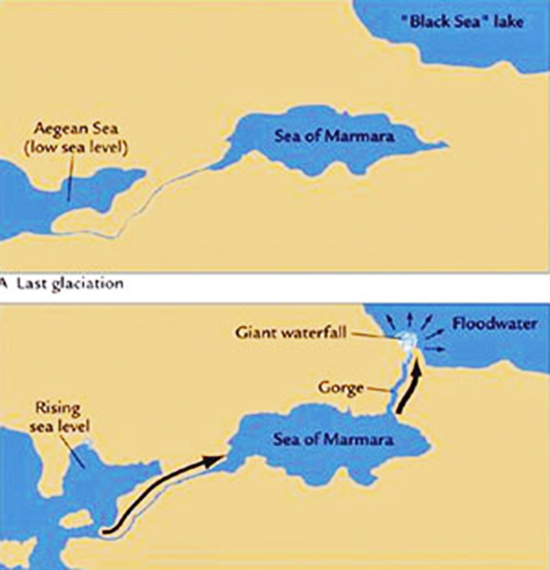
The Black Sea catastrophe, before and after.
The
water from the Aegean Sea
cut
through a narrow Gorge (Bosphorous Strait)
and
plunged into the Black Sea
creating a gigantic waterfall.
Similar major flooding events took place in many parts of the world,
as massive glacial lakes, swelled by the waters of the melting ice,
breached their ice barriers, and rushed into the surrounding areas.
Sometime between 6900 BCE
- 6200 BCE the Laurentide ice-sheet disintegrated in the Hudson Bay
and an enormous quantity of glacial waters from the inland Lake
Agassiz/Ojibway discharged into the Labrador Sea.
This was possibly the
"single largest flood of the Quaternary Period," which may have
single-handedly raised the global sea level by half a meter. 25
The period between 7000
BCE - 6000 BCE was also characterized by the occurrences of gigantic
earthquakes in Europe.
In northern Sweden, some
of these earthquakes caused 'waves on the ground', 10 meters high,
referred to as 'rock tsunamis'. It is possible that the global chain
of cataclysmic events during this transitional period may have been
triggered by a single underlying cause, which we are yet to find
out.
The transitional period between the Dwapara Yuga and Kali Yuga, from
3976 BCE - 3676 BCE, was again marked by a series of environmental
cataclysms, whose exact nature remains a mystery.
It is referred to in
geology as the 5.9 kiloyear event, and is considered one of the most
intense aridification events during the Holocene period.
It occurred around
3900 BCE, ending the Neolithic Sub-pluvial and initiated the
most recent desiccation of the Sahara Desert.
At the same time, between
4000 BCE - 3500 BCE, the coastal plains of Sumer experienced severe
flooding, which,
"was the local effect
of a worldwide episode of rapid, relatively short-term flooding
known as the Flandrian Transgression - which had a significant
impact not only along the shores of the Gulf but in many other
parts of Asia as well." 26
This catastrophic
flooding event led to the end of the Ubaid period in Mesopotamia,
and triggered a worldwide migration to river valleys. Soon
afterwards, we find the emergence of the first river valley
settlements in Egypt, Mesopotamia and the Indus Valley in c. 3500
BCE.
This transitional period between the Yugas is also recorded in
ancient calendars.
For a very long time
there was a prevalent belief in the Western world that the world was
created in 4004 BCE. This date comes to us from the genealogies of
the Old Testament.
The date is just 28 years
prior to the end of the Dwapara and the beginning of the
transitional period.
The year of world
creation in the Jewish religious calendar is 3761 BCE, which is in
the middle of the transitional period.
Greek Dark
Ages & Great Upheavals
As per the ancient traditions, the descending Kali Yuga, which was
referred to by Hesiod as the 'Age of Heroes', came to an end with
the battle fought on the plains of Troy.
The Yuga Cycle timeline
indicates that the 300-year intervening period between the
descending and ascending Kali Yuga extended from 976 BCE - 676 BCE;
and very interestingly, this overlaps with the 300-year period from
1100 BCE to 800 BCE which is referred to by historians as the Greek
Dark Ages!
Historians regard the Greek Dark Ages as a period of transition from
the Late Bronze Age to the Early Iron Age. Robert Drews writes that:
Within a period of
forty to fifty years at the end of the thirteenth and the
beginning of the twelfth century (c.1200 - 1100 BCE) almost
every significant city in the eastern Mediterranean world was
destroyed, many of them never to be occupied again. 27
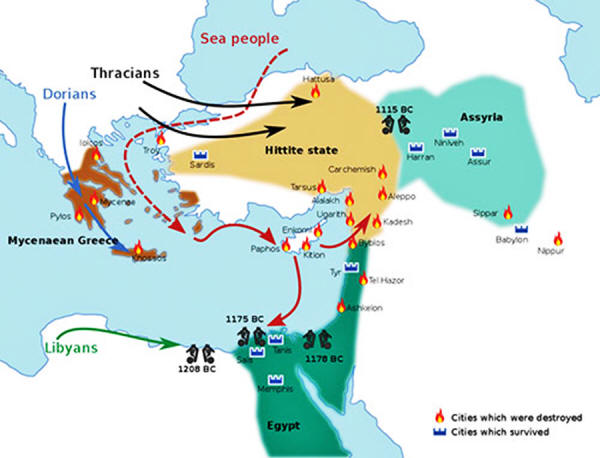
Map of
the Late Bronze Age collapse
in the
Eastern Mediterranean
along
with movements of people.
This sudden and violent
disruption plunged the entire Near East, North Africa, Caucasus,
Aegean, and Balkan regions into a Dark Age that lasted for three
hundred years, and was characterized by,
Almost,
every city between
Pylos and Gaza was violently destroyed, and many abandoned.
The palace economies
of Mycenae and Anatolia collapsed, and people lived in isolated,
small settlements.
In Egypt, the period from 1070 BCE - 664 BCE is known as the
'Third Intermediate Period' during which time Egypt was overrun
by foreign rulers. There was political and social disintegration
and chaos, accompanied by a series of crippling droughts.
In India, the Indus
Valley civilization finally ended around 1000 BCE, and after a
gap of nearly 400 years we see the emergence of the 16 Great
Kingdoms (Mahajanapadas) in the Gangetic Plains at around 600
BCE.
Catastrophe also
struck the Olmec civilization of Mesoamerica at this time.
A wholesale
destruction of many San Lorenzo monuments occurred in c.950 BCE
and the site was abandoned in c.900 BCE.
Scholars believe
drastic environmental changes may have been responsible for this
shift in Olmec centers, with certain important rivers changing
course.
When the ascending Kali
Yuga began in 676 BCE, much of the knowledge, traditions, and skills
from the descending Kali Yuga were forgotten.
Possibly in response to
this grave social crisis, a number of philosophers and
prophets appeared at this time, trying to re-discover
the lost wisdom, and spread it amongst the ignorant masses.
Among them were,
But much sacred knowledge
was irretrievably lost.
For instance, the
original Vedas were comprised of 1,180 sakhas (i.e. branches), of
which only 7 or 8 sakhas (less than 1%) are remembered now.
Various errors,
omissions, and interpolations also crept into the ancient texts as
they were being revised and written down.
The mistakes in the Yuga
Cycle doctrine were some of them.
The Yuga Cycle
timelines proposed here accurately mirrors the worldwide
environmental catastrophes that accompany transitional periods
between Yugas.
Every 2,700 years our
planet is impacted by a series of cataclysmic events for a
period of a few hundred years, which brings about a total or
near total collapse of civilizations across the world.
In every case,
however, civilization restarts immediately after the period of
destruction.
The four key
transitional periods, since the end of the Golden Age, are
summarized in the below table.
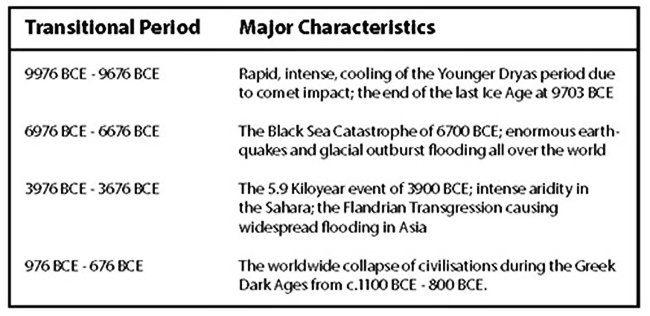
The
Transitional Periods between Yugas
It is evident that the
Yuga Cycle used to be tracked using the Saptarishi Calendar.
It was of 12,000 years
duration, comprised of four Yugas of equal duration of 2,700 years
each, separated by transitional periods of 300 years. The complete
Yuga Cycle of 24,000 years was comprised of an ascending and
descending Yuga cycle, which followed each other for eternity like
the cycles of day and night.
For the past 2,700 years
we have been passing through the ascending Kali Yuga, and this Yuga
is coming to an end in 2025.
In accordance with convention, the 300-year transitional period
following 2025 can be broken into two periods of 150 years each.
The first 150-year
period - the 'Twilight of Kali' - is when the Kali Yuga
structures may collapse due to a combination of wars,
environmental catastrophes, and cosmic changes.
The second 150-year
period - the 'Dawn of Dwapara' - is the time when the
spiritually evolved systems and philosophies of the Dwapara Yuga
may begin to emerge.
It is likely, though,
that the twin processes of collapse and
emergence will progress simultaneously throughout the entire
300-year transitional period, albeit at different intensities.
The current upswing in tectonic activities and extreme weather
phenomena on one hand, and the initial signs of the awakening of a
higher consciousness amongst humanity on the other, may be
indicative of the fact that the effects of the transitional period
are already underway.
We need to be aware of
these greater cycles of time that govern human civilization,
and the changes that are looming in the horizon...
Footnotes
1. Krishna-Dwaipayana
Vyasa, The Mahabharata, trans. Kisari Mohan Ganguli (1883-1896)
book 3, chapter CXLVIII, from Internet Sacred Texts Archive,
www.sacred-texts.com
2. Aryabhatiya,
Kalakriyapada, verse 10
3. D.C. Sircar,
Indian Epigraphy, Motilal Banarsidass Publ., 1965, 318
4. Richard Salomon,
Indian Epigraphy: A Guide to the Study of Inscriptions in
Sanskrit, Prakrit, and the other Indo-Aryan Languages, Oxford
University Press, 1998, 181
5. Surya-Siddhanta: A
Text-Book of Hindu Astronomy, tr. Ebenezer Burgess, Phanindralal
Gangooly, Motilal Banarsidass Publ., 1989, Chapter 1, 41
6. Lokamanya Bâl
Gangâdhar Tilak, The Arctic Home in the Vedas, Messrs. TILAK
BROS, 1903
7. The Mahabharata,
tr.Kisari Mohan Ganguli, Book 12: Santi Parva, Section CCXXXI
8. Laws of Manu, tr.
G. Buhler, Chapter 1 verses 69, 70, 71
9. Sri Yukteswar, The
Holy Science, 1894, xi
10. Jenny Strauss
Clay, Hesiod's Cosmos, Cambridge University Press, 2003, 83
11. Alberuni's India
(AD 1030), trans. Dr. Edward C. Sachau, London, 1910, Chapter
XLII 373-374
12. Ibid, 375
13. Ibid, 376
14. Subhash Kak, "On
the Chronological Framework for Indian Culture", Indian Council
of Philosophical Research (2000), 1-24
15. J.E. Mitchiner,
Traditions of the Seven Rishis, Motilal B, 1982, 163
16. Pliny, Naturalis
Historia, 6.59-60
17. Arrian, Indica
9.9
18. Encyclopaedia
Londinensis Vol 21 (1826) 677
19. Sir William
Jones, "On the Gods of Greece, Italy and India", Asiatic
Researches vol. 1 (1788), 221-75
20. Subhash Kak, "On
the Chronological Framework for Indian Culture", Indian Council
of Philosophical Research (2000), 1-24
21. Luigi Piccardi
and Bruce Masse, Myth and Geology, Geological Society of London
Special Publication, 2007, 273
22. "Nanodiamond-Rich
Layer across Three Continents Consistent with Major Cosmic
Impact at 12,800 Cal BP", The Journal of Geology, 2014, volume
122, 475–506
23. "Danish Arctic
research dates Ice Age", 11 Dec. 2008,
politiken.dk/newsinenglish/article611464.ece
24. "Geologists Link
Black Sea Deluge To Farming's Rise", New York Times, 17 Dec.
1996
25. Graham Hancock,
Underworld: The Mysterious Origins of Civilization, Three Rivers
Press, 2002, 82-83
26. Ibid, 31
27. Robert Drews, The
End of the Bronze Age: Changes in Warfare and the Catastrophe
ca. 1200 B.C., Princeton University Press, 1993, 4
| 









